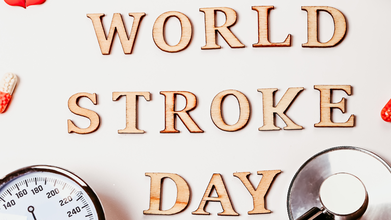- Health Conditions A-Z
- Health & Wellness
- Nutrition
- Fitness
- Health News
- Ayurveda
- Videos
- Medicine A-Z
- Parenting
- Web Stories
'In Sickness And In Health' Or Not? Study Finds Husbands Are More Likely To Leave Their Sick Wives

Till Death Do Us Part, or maybe not. The classic marriage vow is to stay together “in sickness and in health” bounds couples to support each other no matter what. However, new research shows that when illness strikes, this promise isn’t always kept, especially if it is the wife who becomes ill.
A major new study published in February 2025 in the Journal of Marriage and Family found that marriages are about seven times more likely to end when the wife becomes seriously ill compared to when the husband does. While most marriages survive a health crisis, this gender gap raises difficult questions about caregiving, emotional support, and the psychological toll of illness on relationships.
The Study: Tracking Couples Across Europe
Researchers Daniele Vignoli, Giammarco Alderotti, and Cecilia Tomassini followed more than 25,000 heterosexual couples aged 50 and above, across 27 European countries, over an 18-year period. Couples were surveyed repeatedly about their physical health, mental health, daily functioning, and relationship status.
The study focused on two groups: couples aged 50 to 64 and those aged 65 and older, to understand how age and life stage may influence relationship stability when illness strikes.
Younger Couples: When Wives Get Sick, Divorces Rise
The most striking findings came from couples between 50 and 64. When wives reported poor health but husbands remained well, the marriage was significantly more likely to end compared to couples in which both partners were healthy.
The same was true for limitations in daily life. If the wife struggled with everyday tasks but the husband did not, the couple’s risk of divorce increased. Interestingly, the reverse pattern, a sick or limited husband with a healthy wife, did not significantly increase the likelihood of divorce.
Mental health also played a role. Wives experiencing depression were more likely to face separation, whereas husbands’ depression did not have the same effect.
Older Couples: Depression Matters Most
Among couples in which at least one partner was 65 or older, physical illness was less strongly associated with divorce. Instead, depression became the main predictor of marital breakdown, but again, only when it was the wife who was depressed. If husbands were depressed but wives were not, the marriage was just as likely to continue as if neither partner had depression.
The Psychological Angle: Caregiver Stress and Gender Roles
Why are marriages more likely to end when the wife gets sick? The researchers did not test specific explanations but suggested that caregiving roles may play a central part. In most heterosexual marriages, wives traditionally take on the bulk of caregiving tasks. When they become unable to fulfill that role, couples may experience more stress, both practically and emotionally.
Psychologists suggest that men may enter marriage with an implicit expectation of being cared for. When illness requires them to become the primary caregiver, some may find the role emotionally overwhelming or inconsistent with their expectations, leading to marital breakdown.
Financial dynamics may also matter. Women in this age group are often more economically vulnerable and may face barriers to leaving a stressful marriage even when they want to. This means that when divorces do happen, they may be driven by the healthier spouse, in this case, the husband.
Previous Research Paints a Similar Picture
This is not the first study to highlight this troubling trend. Earlier research on couples in which one partner was diagnosed with a brain tumor or multiple sclerosis found that 21% of marriages ended when the wife was the patient, compared to just 3% when the husband was the one who was ill.
That sevenfold difference reinforces the idea that illness affects women’s marriages more than men’s — a finding that has serious psychological implications for women facing chronic disease.
Life After Divorce: The Resilience of Singles
Interestingly, research also shows that people who have always been single, sometimes referred to as “single at heart”, often cope better with illness or life transitions than those who divorce later in life. Lifelong singles typically maintain strong friendships, community ties, and the skills needed to navigate daily life on their own.
This raises an important point: the fear that single people will have “no one” to care for them may be misplaced. Marital status does not guarantee emotional or physical support, and as this study shows, women may actually face a higher risk of abandonment when ill.
A Call to Rethink Support Systems
The findings carry significant implications for public health and mental health services. If women are more vulnerable to relationship breakdown during illness, they may need additional psychological, social, and financial support.
Experts suggest normalizing conversations about caregiving roles early in marriage, encouraging men to participate more equally in domestic and emotional labor, and providing counseling for couples navigating health crises. Strengthening social safety nets and peer support networks could also help buffer the psychological stress of both illness and divorce.
Not Turning Off The Light At Night Could Be The Top Cause Of Death Worldwide, Finds Study

Credits: Canva
Nighttime Light Exposure: How you spend the night sleeping whether with the light on or off, could actually determine how long you live. A new study published in JAMA Network Open finds that turning off the lights at night is not just good for a restful sleep, but it could lower the risk for cardiovascular disease, which is a top cause of death worldwide.
What Did The Study Find?
The new research found that people who slept in the brightest conditions, especially with having overhead bedroom lights on, had a 56% greater risk of developing heart failure. Those who slept under such an intense light also had a 32% increased risk of coronary artery disease and a 28% increase of stroke.
Also Read: The 'BEFAST' Trick Could Help You Detect Your Stroke Before It Happens, According To Doctor
How Was The Study Conducted?
The study tracked its participants through wrist wearable. The exposure to light intensity between 12.30am to 6am was measured, as said by Dr Daniel Windred, co-first author of the study. He is a research associate at Flinders University's College of Medicine and Public Health in Australia.
“One limitation is that we do not know the sources of personal light exposure, only the intensity,” said Windred. “Understanding typical sources of night light exposure might allow for more informed recommendations beyond ‘avoid bright light at night.’”
The study analyzed 13 million hours of light data, which came from 89,000 people.
Why Does Turning The Light Off At Night Protects You From Cardiovascular Diseases?
The explanation lies in the brain's production of sleep-inducing hormone melatonin, which can be blocked by the light. This is why reducing light exposure at night could make you sleep better. It also means to limit screen time as much as possible and switch off unnecessary household lights within four hours of bed time.
Windred says that if turning the light off is not possible, you may try to dim it down or use warm lighting, instead of bright overhead lights. Another thing that must be followed is to avoid using bright alarm clocks, and sleeping near windows, as lights could come through that. In case that too is not possible, you may use light-blocking window shades, or blackout curtains, and even your sleep mask on your eyes.
Circadian rhythms are 24-hour cycles "in virtually every cell and tissue in our body, including our cardiovascular system," said Windred. This internal clock helps you sleep and also wake up, especially by detecting light as a signal.
Disruption of circadian rhythms by light has been shown to interfere with several cardiovascular and metabolic processes, in many earlier studies too. It can damage cells that support healthy artery function, contribute to high blood pressure, and raise the risk of related diseases. Such circadian disruption may also increase the likelihood of blood clots, potentially triggering strokes or heart attacks.
Limitation Of The Study
While the study did find that exposed to brightest light had a 47% greater risk of having a heart attack, and a 32% increased risk of developing atrial fibrillation. The study did not prove light exposure cause cardiovascular issues, it only showed the link. “There may be other differences in people exposed to light at night that are responsible for the greater risk of heart disease,” said Dr. Tim Chico, professor of cardiovascular medicine at the University of Sheffield in England, in a statement provided by the Science Media Centre. Chico wasn’t involved in the research.
The 'BEFAST' Trick Could Help You Detect Your Stroke Before It Happens, According To Doctor

Credits: Canva
October 29 is observed as the World Stroke Day, annually. This day is recognized throughout the world and is observed to increase awareness of one of the leading causes of death and disability.
A stroke could happen to anyone, at any place, yet many people are not aware of the risk factors. This is why this day is observed worldwide, to bring attention on the warning signs and stroke prevention.
What Is The BEFAST Trick To Notice Stroke Signs?
Talking about warning signs, Dr Deep Das, a Neurologist at CMRI Kolkata says that the BEFAST trick could work best to notice for any early stroke system.
BEFAST stands for:
- B - Balance
- E - Eye or vision
- F - Face; Dr Das suggests to notice if the face becomes distorted
- A - Arm; the doctor suggests to check for weakness or loss of grip
- S - Speech; the suggestion is to look for slurred or unclear speech
- T - Time; the key is to act immediately without wasting anytime
"What makes a real difference is how quickly a stroke is diagnosed," notes Dr Das. The doctor also points out that with the advent of AI, the diagnosis could be done way faster. "Traditionally, stroke diagnosis and treatment have relied heavily on clinical expertise and imaging techniques, which could sometimes lead to delays in decision-making. AI has significantly enhanced these processes by providing rapid image analysis and predicting stroke outcomes with high accuracy."
World Stroke Day 2025: Theme
This year, the theme is 'Every Minute Counts'. The theme emphasizes on recognizing the symptoms and act fast on it, exactly what Dr Das also pointed out. On this, Dr Anjani Kumar Sharma, Director of Neuroscience at CK Birla Hospitals in Jaipur says, "World Stroke Day serves as a powerful reminder that stroke is a medical emergency that can affect anyone, anywhere, but it is also largely preventable." This is why every minute spent is crucial.
Dr Sharma says, "The acronym FAST, Face drooping, Arm weakness, Speech difficulty, Time to call emergency services — should be known to everyone." The doctor further adds that nearly 80% of strokes can be prevented through simple but consistent measures: controlling blood pressure and diabetes, avoiding tobacco and alcohol, eating a balanced diet, exercising regularly, and managing cholesterol. "Stroke is not the end," notes the doctor, "with timely medical intervention and focused rehabilitation, patients can regain independence and quality of life".
World Stroke Day Origin And Importance
The idea to celebrate a stroke day was initiated back in 2006 by global health leaders who recognized the importance of launching global movements and advocate against strokes. This has led to it being an important health event that focuses on educating the public on stroke warning signs, promoting prevention by keeping a healthy diet, as well as supporting survivors.
"As neurologists, we witness every day how stroke can strike suddenly, disrupting not only the life of an individual but also their family and community. Yet, what is heartening is that stroke is preventable, treatable, and increasingly survivable when recognized early," notes Dr Pushkar Gupta, Direct of Neurology at CK Birla Hospitals, Jaipur. The doctor says that the message for World Stroke Day is clear - to spread awareness and save lives.
Doctor Issues Warning To Anyone Taking Omeprazole For Acid Reflux — Here’s Why It Could Be Risky

Credits: Canva
BBC Morning Live’s Dr Punam Krishan has cautioned people who regularly use proton pump inhibitors (PPIs) such as omeprazole to manage heartburn, acid reflux, and indigestion. In the UK, one in four adults experiences acid reflux, especially after large meals, and many turn to PPIs to relieve symptoms. However, Dr Punam explained that long-term use of these medications could pose certain health risks and urged patients to have their prescriptions reviewed regularly.
Dr Punam, a practising NHS GP and resident medical expert on BBC’s Morning Live, is also a well-known health broadcaster and author of children’s books.
Omeprazole Warning For Acid Reflux
Speaking to hosts Gethin Jones and Helen Skelton, she began by explaining how acid reflux develops. “Acid reflux happens when stomach acid travels back up the food pipe,” she said. “We all have acid in our stomach, it plays a key role in breaking down food. A small valve, or sphincter, at the top of the stomach acts like a trapdoor to keep that acid in place. But when this valve becomes weak or too relaxed, the acid can flow back up the oesophagus, leading to that burning, heavy sensation people often describe.”
She added that large meals, alcohol, and lying down soon after eating can all make reflux worse.
When asked how reflux is usually treated, Dr Punam explained: “If you only experience symptoms occasionally, over-the-counter medicines like antacids or alginates, such as Gaviscon can help by neutralising stomach acid. They’re effective for mild cases and can be used as needed.”
“For ongoing discomfort, we prescribe proton pump inhibitors, or PPIs, like omeprazole or lansoprazole. These medicines are highly effective and have changed the way we treat acid reflux by targeting acid production directly at the source.”
Why Long-Term Use of PPIs Can Be Risky
Dr Punam warned that while PPIs are safe when used correctly, they are not intended for indefinite use. “These medications shouldn’t be taken unnecessarily or for long periods without medical review,” she said. “Extended use can slightly raise the risk of low magnesium or vitamin B12 levels and increase the likelihood of gut infections, particularly Clostridioides difficile, known as C. diff.”
She explained that C. diff is a bacterium that naturally exists in the gut but can overgrow when the balance is disturbed, sometimes causing persistent diarrhoea. “That’s a warning sign,” she said. “If you develop diarrhoea or notice changes in your bowel habits, speak to your doctor immediately. It’s very important to keep up with regular GP reviews if you’re on PPIs long-term.”
How Often Should People on PPIs See a Doctor?
If you are using omeprazole without a prescription, you should not continue for more than two weeks. See a doctor if:
- Your symptoms don’t improve after 14 days.
- Your symptoms get worse.
- Your symptoms return within four months of finishing treatment.
- You notice red flag signs such as difficulty swallowing, vomiting blood, or black stools.
© 2024 Bennett, Coleman & Company Limited

